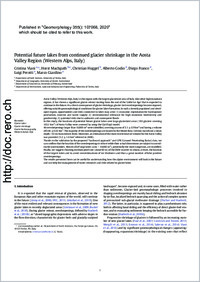Potential future lakes from continued glacier shrinkage in the Aosta Valley Region (Western Alps, Italy)
- Viani, Cristina Department of Earth Sciences, University of Torino, Italy
- Machguth, Horst Department of Geography, University of Zurich, Switzerland - Department of Geosciences, University of Fribourg, Switzerland
- Huggel, Christian Department of Geography, University of Zurich, Switzerland
- Godio, Alberto Department of Environment, Land and Infrastructure Engineering, Politecnico di Torino, Italy
- Franco, Diego Department of Environment, Land and Infrastructure Engineering, Politecnico di Torino, Italy
- Perotti, Luigi Department of Earth Sciences, University of Torino, Italy
- Giardino, Marco Department of Earth Sciences, University of Torino, Italy
-
15.04.2020
Published in:
- Geomorphology. - 2020, vol. 355, p. 107068
English
Aosta Valley (Western Alps, Italy) is the region with the largest glacierized area of Italy. Like other high mountain regions, it has shown a significant glacier retreat starting from the end of the ‘Little Ice Age’ that is expected to continue in the future. As a direct consequence of glacier shrinkage, glacier-bed overdeepenings become exposed, offering suitable geomorphological conditions for glacier lakes formation. In such a densely populated and developed region, opportunities and risks connected to lakes may arise: 1) economic exploitation for hydropower production, tourism and water supply; 2) environmental relevance for high mountain biodiversity and geodiversity; 3) potential risks due to outbursts and consequent floods.In this study, the locations of potential future glacier lakes over large glacierized areas (183 glaciers covering 163,1 km2) of Aosta Valley were assessed by using the GlabTop2 model.46 overdeepenings larger than 10,800 m2 were identified, covering an area of 3.1 ± 0.9 km2 and having a volume of 0.06 ± 0.02 km3. The majority of the overdeepenings are located in the Monte Rosa-Cervino massif and a mean depth <10 m characterizes them. Moreover, an estimation of the most recent total ice volume for the Aosta Valley was provided (5.2 ± 1.6 km3 referred to 2008).Thanks to the validation by the proposed “backward approach” and GPR (Ground Penetrating Radar) data, we can confirm that the location of the overdeepenings is robust while their actual dimensions are subject to considerable uncertainties. Almost all of large lakes (area > 10,000 m2), potentially the most dangerous, are modelled. Finally, we suggest choosing medium pixel size (about 60 m) of the DEM in order to obtain, at least, the location of the largest lakes and to avoid overestimations of ice thickness and thus a great number of false positive overdeepenings.The results presented here can be useful for understanding how the alpine environment will look in the future and can help the management of water resources and risks related to glacier lakes.
- Faculty
- Faculté des sciences et de médecine
- Department
- Département de Géosciences
- Language
-
- English
- Classification
- Geology
- License
-
License undefined
- Identifiers
-
- RERO DOC 328438
- DOI 10.1016/j.geomorph.2020.107068
- Persistent URL
- https://folia.unifr.ch/unifr/documents/308497
Statistics
Document views: 136
File downloads:
- pdf: 394
